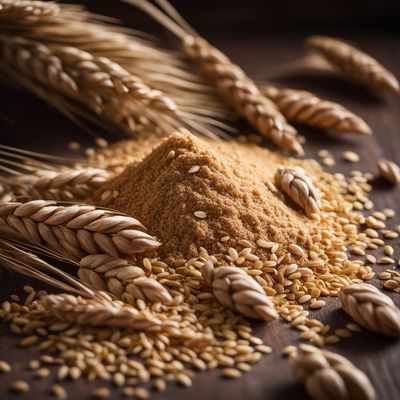
Ingredient
Sorghum flour
Sorghum Flour: A Nutritious and Gluten-Free Alternative
Sorghum flour is a finely ground flour made from the sorghum grain, a cereal crop native to Africa. It has a mild, slightly sweet flavor and a fine texture that closely resembles wheat flour. Sorghum flour is rich in fiber, protein, and essential nutrients, including iron, magnesium, and B vitamins. Its gluten-free nature makes it a valuable ingredient for individuals with celiac disease or gluten sensitivities.
Origins and history
Sorghum has a long history of cultivation in Africa and has been a staple food for many African communities for centuries. It is drought-tolerant and can thrive in arid regions, making it an important crop in areas with limited water resources. Sorghum flour is widely used in African, Indian, and Middle Eastern cuisines, where it is used to make traditional dishes such as flatbreads, porridges, and fermented beverages. In recent years, sorghum flour has gained popularity worldwide as a gluten-free alternative in baking and cooking.
Nutritional information
Sorghum flour is a nutrient-dense ingredient that provides dietary fiber, protein, and essential minerals. It is also naturally gluten-free, making it a suitable choice for individuals with celiac disease or gluten sensitivities. Additionally, sorghum flour has a lower glycemic index compared to wheat flour, which means it has a lesser impact on blood sugar levels.
How to select
When selecting sorghum flour, look for a product that is finely ground and free from any signs of moisture or clumping. Check the packaging for any certifications or labels indicating that it is gluten-free. It is also advisable to purchase sorghum flour from reputable brands or suppliers to ensure quality and purity.
Storage recommendations
To maintain the freshness and quality of sorghum flour, store it in an airtight container in a cool, dry place, away from direct sunlight. Properly stored, sorghum flour can last for up to 6 months. It is advisable to check for any signs of spoilage, such as a rancid smell or insect infestation, before using.
How to produce
Sorghum can be grown in a variety of climates, including both temperate and tropical regions. It can be cultivated from seeds, which are readily available from agricultural suppliers. Growing sorghum requires well-drained soil, ample sunlight, and regular watering. Detailed cultivation guides and resources are available for amateur growers interested in producing their own sorghum flour.
Preparation tips
Sorghum flour can be used as a one-to-one substitute for wheat flour in many recipes. It is commonly used in gluten-free baking to make bread, cakes, cookies, and pancakes. It can also be used as a thickening agent in soups, sauces, and gravies. When using sorghum flour, it is important to note that it absorbs more liquid than wheat flour, so adjustments may be needed in the recipe. Experiment with different ratios and combinations to achieve the desired texture and taste.
Substitutions
Rice flour, millet flour, or buckwheat flour can be used as substitutes for sorghum flour. Each alternative will bring a slightly different flavor and texture to the final product, so it is important to consider the desired outcome when choosing a substitute.
Culinary uses
Sorghum flour is widely used in gluten-free baking to make bread, cakes, cookies, and other baked goods. It is also used as a thickening agent in soups, sauces, and gravies. In African, Indian, and Middle Eastern cuisines, sorghum flour is used to make traditional dishes such as flatbreads, porridges, and fermented beverages. Its versatility and nutritional benefits have made it a popular choice among individuals with gluten sensitivities and those seeking alternative flours.
Availability
Sorghum is cultivated in various regions around the world, including Africa, India, China, and the United States. It is commonly available in grocery stores, health food stores, and online retailers that specialize in gluten-free products.
More ingredients from this category » Browse all

Maize, milled
Golden Grain: Unleashing the Power of Milled Maize

Cereal and cereal-like flours not separately listed
The Flour Power: Unleashing the Versatility of Cereal and Cereal-Like Flours

Flour mix (like wheat/rye/barley/oats and other)
Versatile Blend for Every Recipe

Rice flour
The Versatile Grain Powder

Millet flour
The Ancient Grain: Millet Flour

Amaranth flour
The Ancient Grain Flour with a Nutty Twist

Wheat flour
The Versatile Grain: Exploring the Wonders of Wheat Flour

Spelt flour
The Ancient Grain of Spelt

Rye flour
Hearty Grain

Buckwheat flour
The Nutty Powerhouse: Buckwheat Flour

Barley flour
The Nutritional Powerhouse: Barley Flour

Oat flour
The Wholesome Power of Oat Flour
Recipes using Sorghum flour

Bogobe jwa lerotse with a Burkinabé twist
Savory Sorghum Porridge: A Burkinabé Delight

Indian Chinese Oshifima
Spicy Fusion Oshifima: A Delectable Blend of Indian Chinese Flavors

Homemade Soba Boro
Crispy Soba Delights: Homemade Soba Boro Recipe

South Sudanese Pineapple Upside Down Cake
Tropical Delight: South Sudanese Pineapple Upside Down Cake

Bogobe Jwa Lerotse - Traditional African Sorghum Porridge
Savory African Sorghum Porridge: A Taste of Tradition

Kisra - Sudanese Sorghum Flatbread
Savory Delight: Kisra - A Taste of Sudanese Tradition